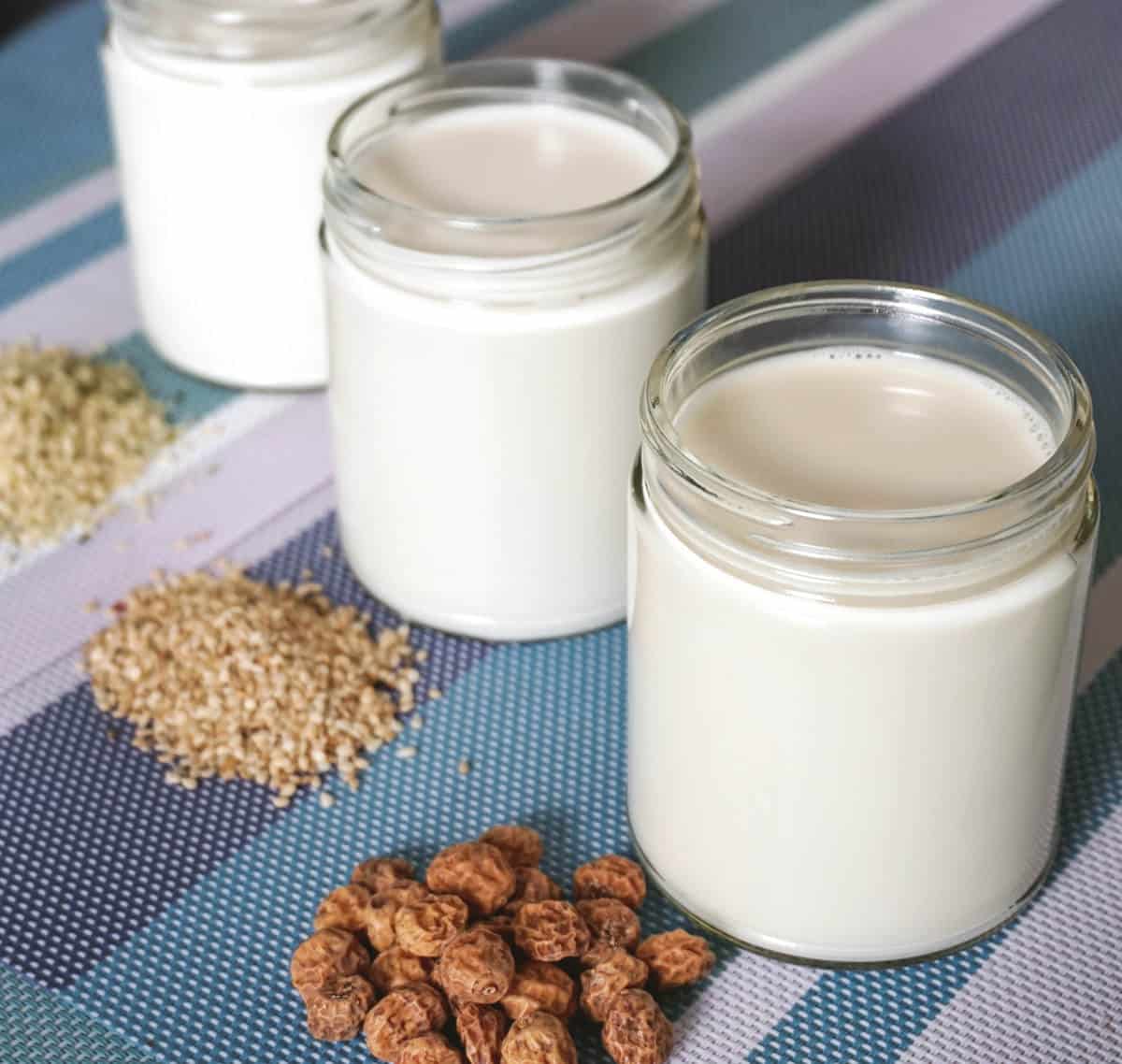Discover the creamy, delicious world of homemade nut-free milk alternatives! This guide unveils simple, step-by-step recipes for crafting your own oat, sunflower seed, and soy milk, bypassing common allergens and embracing a healthier, more personalized approach to plant-based beverages. Imagine the satisfying process of transforming humble ingredients into a nutritious and flavorful drink, perfectly tailored to your taste. Learn to control the texture and sweetness, avoiding unwanted grains or off-flavors, and unlock the secrets to achieving perfectly creamy, delicious milk alternatives right in your own kitchen.
We’ll explore the nutritional benefits of each milk type, comparing them to traditional dairy milk and providing a detailed nutritional breakdown. From soaking seeds to mastering the perfect blend, we’ll guide you through each stage of the process, ensuring your homemade milk is not only healthy but also incredibly satisfying. Get ready to embark on a culinary adventure that will revolutionize your morning routine and elevate your plant-based lifestyle.
Popular Nut-Free Milk Alternatives

Making your own nut-free milk alternatives at home offers a delicious and healthy way to control ingredients and avoid potential allergens. This allows for customization of sweetness and texture, creating a personalized beverage experience. Below, we explore several popular options, detailing their unique characteristics and nutritional profiles.
Popular Nut-Free Milk Alternatives: Taste, Texture, and Nutritional Benefits
Several delicious and nutritious nut-free milk alternatives can be easily crafted at home. These options provide diverse flavor profiles and nutritional benefits, catering to various dietary needs and preferences.
- Oat Milk: Creamy and subtly sweet, oat milk boasts a mild flavor that complements many dishes. Its texture is often described as smooth and velvety, making it ideal for both drinking and using in recipes. Nutritionally, oat milk is a good source of fiber, which aids digestion and contributes to feelings of fullness. Compared to dairy milk, it often contains less protein but is comparable in carbohydrate content, though the fiber content significantly boosts its nutritional value.
- Soy Milk: Soy milk offers a slightly beany flavor, though modern processing techniques have minimized this for many commercially available brands. The texture is generally smooth and consistent, similar to cow’s milk. Soy milk is a complete protein source, meaning it contains all nine essential amino acids, making it a superior choice for protein intake compared to most other plant-based milks. It also offers isoflavones, compounds associated with various health benefits.
- Rice Milk: Rice milk possesses a mild, slightly sweet taste, often described as delicate and inoffensive. Its texture is thin and watery compared to other milk alternatives. While low in protein and fat, rice milk is a good source of carbohydrates and is often easily digestible, making it suitable for those with sensitive stomachs. Compared to dairy milk, it lacks the significant protein and fat content.
- Coconut Milk (from Coconut Flesh): Made from the flesh of coconuts, this milk offers a distinctly rich and creamy texture with a pronounced coconut flavor. It’s naturally sweet and lends itself well to desserts and smoothies. Coconut milk is higher in saturated fat than other alternatives and contains less protein, but it is a good source of medium-chain triglycerides (MCTs), which are quickly metabolized for energy.
- Sunflower Seed Milk: This milk alternative offers a slightly nutty and subtly sweet flavor, with a creamy texture that is often smoother than almond milk. It is a good source of vitamin E, a powerful antioxidant, and is naturally cholesterol-free. Compared to dairy milk, it contains less protein but offers a good source of healthy fats and essential nutrients.
Nutritional Comparison Table
The following table provides a general comparison of the nutritional content (per serving) of the discussed milk alternatives. Note that values can vary depending on the specific recipe and ingredients used. These values represent approximate averages based on commonly available recipes.
| Milk Type | Protein (g) | Fat (g) | Carbohydrates (g) |
|---|---|---|---|
| Oat Milk | 2-4 | 2-5 | 10-15 |
| Soy Milk | 7-8 | 3-5 | 5-8 |
| Rice Milk | 1-2 | 0.5-1 | 12-15 |
| Coconut Milk (from flesh) | 2-3 | 15-20 | 5-8 |
| Sunflower Seed Milk | 3-5 | 6-8 | 5-7 |
Step-by-Step Guide: Making Soy Milk
Creating your own soy milk at home is a rewarding process, allowing you to control the ingredients and sweetness, resulting in a fresh and flavorful beverage. This detailed guide walks you through each step, highlighting the differences from other plant-based milk alternatives.
Soy Milk Recipe
This recipe yields approximately four cups of soy milk. Begin by soaking one cup of dried soybeans in at least four cups of filtered water for at least eight hours, or preferably overnight. This soaking process softens the beans, making them easier to blend and improving the digestibility of the final product. After soaking, rinse the soybeans thoroughly under cold running water.
Next, combine the soaked soybeans with six cups of fresh water in a high-powered blender. Blend until completely smooth and creamy, scraping down the sides as needed. This process typically takes several minutes. The resulting mixture will be thick and somewhat coarse.
Strain the blended mixture through a nut milk bag or a fine-mesh sieve lined with cheesecloth. This removes the soy pulp, leaving behind the creamy soy milk. Squeeze the bag or cheesecloth firmly to extract as much liquid as possible. The remaining pulp can be used in other recipes, such as veggie burgers or bread.
Finally, heat the soy milk gently over medium heat in a saucepan. Do not boil. Sweeten to taste with maple syrup, agave nectar, or another preferred sweetener. You can also add vanilla extract or other flavorings for enhanced taste. Once heated through, the soy milk is ready to enjoy. Store any leftover soy milk in an airtight container in the refrigerator for up to five days.
Comparison with Other Nut-Free Milk Alternatives
Making soy milk differs from producing other nut-free milk alternatives primarily in the initial soaking process. Oats, for example, typically require less soaking or none at all. However, all processes share similarities in the blending and straining steps. The final heating process is also common across various plant-based milk creations. The key difference lies in the starting ingredient and its inherent properties – soybeans require a longer soak due to their tough outer skin.
Health Benefits and Drawbacks of Soy Milk
Soy milk is a good source of plant-based protein and contains isoflavones, which are compounds with potential health benefits, including reducing the risk of certain cancers and improving bone health. However, some individuals may experience digestive discomfort, such as bloating or gas, due to the presence of oligosaccharides. Additionally, soy milk is often fortified with calcium and vitamin D to match the nutritional profile of dairy milk, but the levels and types of fortification can vary among brands and homemade versions. It’s important to note that while soy milk offers several health advantages, it’s crucial to consider individual tolerance and dietary needs. A balanced diet is key to overall health.
Soy Milk Production Flowchart
Imagine a flowchart starting with a rectangle labeled “Soak Soybeans (8+ hours)”. An arrow leads to a rectangle “Rinse Soybeans”. Another arrow points to a rectangle “Blend Soybeans with Water”. A subsequent arrow connects to a rectangle “Strain Mixture (Nut Milk Bag/Cheesecloth)”. From there, an arrow points to a rectangle “Heat Gently (Do Not Boil)”. A final arrow leads to a rectangle “Sweeten & Flavor (Optional)”. This visual representation clearly Artikels the sequential steps involved in making soy milk.
Troubleshooting and Tips for Homemade Nut-Free Milks
Making nut-free milk at home can be a rewarding experience, offering control over ingredients and a delicious, customized beverage. However, the process isn’t always smooth sailing. Understanding common pitfalls and implementing effective solutions can significantly improve your results, leading to consistently creamy and flavorful homemade milks. This section addresses potential problems and offers practical advice for achieving optimal texture and taste.
Grainy Texture in Homemade Milk
A grainy texture is a frequent issue when making homemade plant-based milks. This often arises from insufficient blending, leaving behind unprocessed solids. The solution lies in meticulous blending. Use a high-powered blender and blend for an extended period, scraping down the sides as needed, until the mixture is completely smooth and free of any visible particles. Adding a small amount of liquid, such as water or the milk itself, during blending can also aid in achieving a smoother consistency. For particularly fibrous ingredients, straining the mixture through a fine-mesh sieve or nut milk bag after blending can further refine the texture. The resulting milk will have a silky smooth consistency, rather than a gritty one.
Off-Flavors in Homemade Milk
Unpleasant tastes in homemade milk can stem from various factors. Using low-quality or stale ingredients is a primary culprit. Ensure all ingredients are fresh and stored properly. Over-processing can also impart off-flavors; therefore, adhere to the recommended blending times. For soy milk, using properly prepared soybeans is crucial; improperly fermented or stored soybeans can lead to sour or bitter notes. If a slightly bitter taste persists, adjusting the sweetness by adding a touch of maple syrup or another sweetener might help to balance the flavor profile.
Optimizing Taste and Texture of Different Nut-Free Milks
Achieving the desired taste and texture requires careful consideration of the specific milk type. For soy milk, adjusting the soy-to-water ratio can significantly influence the final product. A higher soy-to-water ratio yields a richer, creamier milk, while a lower ratio results in a thinner, lighter milk. For other plant-based milks, experimenting with different blending times and straining techniques can fine-tune the texture. Adding flavor enhancers, such as vanilla extract, dates, or cocoa powder, can enhance the taste and create unique flavor profiles. Remember that slight adjustments to recipes can make a substantial difference in the final product’s quality.
Storing Homemade Nut-Free Milk to Maintain Freshness
Proper storage is vital to prolong the shelf life of your homemade milk and prevent spoilage.
- Store homemade milk in airtight containers in the refrigerator. This prevents oxidation and bacterial contamination.
- Consume homemade milk within 3-5 days for optimal freshness. While some milks may last longer, it’s best to err on the side of caution.
- Consider freezing leftover milk for longer storage. Freeze in airtight containers, leaving some headspace to accommodate expansion.
- Avoid storing milk in containers that react with the milk, such as reactive metals. Glass or food-grade plastic containers are recommended.
- Always check for signs of spoilage, such as off-odors or unusual curdling, before consumption.
Making your own nut-free milk at home is a rewarding experience, empowering you to control ingredients and create a beverage perfectly suited to your needs and preferences. From the satisfying whir of the blender to the creamy texture of the finished product, the entire process is a testament to the power of simple ingredients and a little know-how. This journey beyond commercially produced milks opens a world of possibilities, allowing you to experiment with different flavors and textures, and ultimately, enjoy a healthier and more delicious plant-based drink. So, grab your blender, and let the creamy adventure begin!
Essential FAQs
Can I use tap water to make the milk?
Filtered water is recommended for the best taste and to avoid potential off-flavors from chlorine or other minerals.
How long can I store homemade nut-free milk?
Store homemade milk in an airtight container in the refrigerator for up to 3-5 days. For longer storage, consider freezing it in ice cube trays or containers.
What if my milk is too thin?
Add more of the base ingredient (oats, seeds, etc.) next time or blend for a longer duration. You can also try adding a thickening agent like chia seeds or flaxseed meal.
What if my milk is too thick?
Add more water during the blending process. Adjust the liquid to solid ratio to achieve your desired consistency.
Can I sweeten my homemade milk?
Yes! Add maple syrup, agave nectar, or other sweeteners to taste after straining. Start with small amounts and adjust to your preference.


